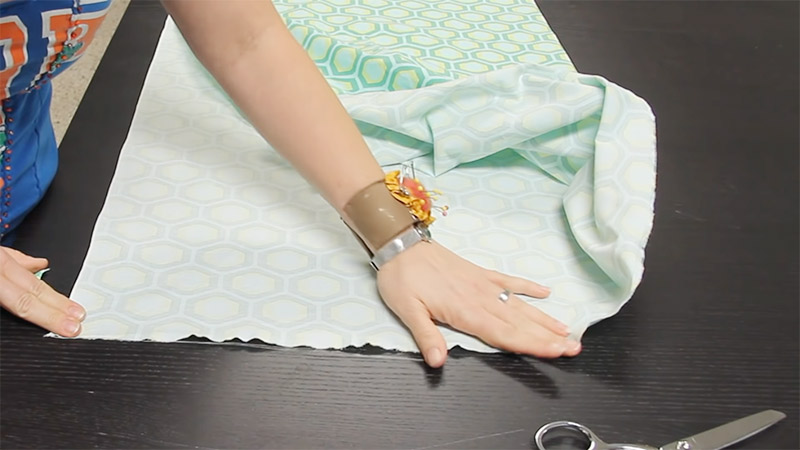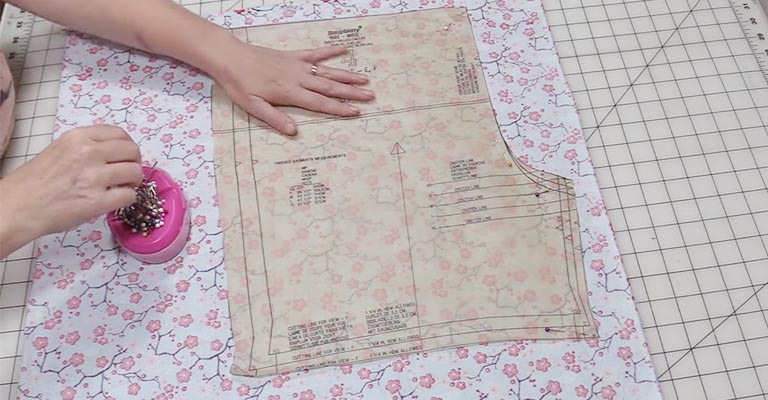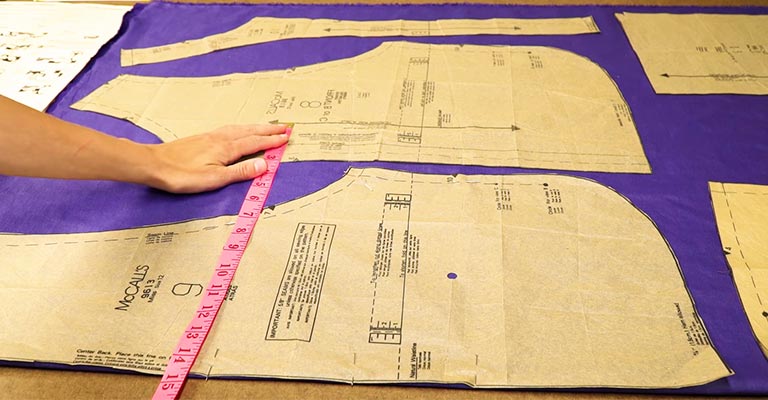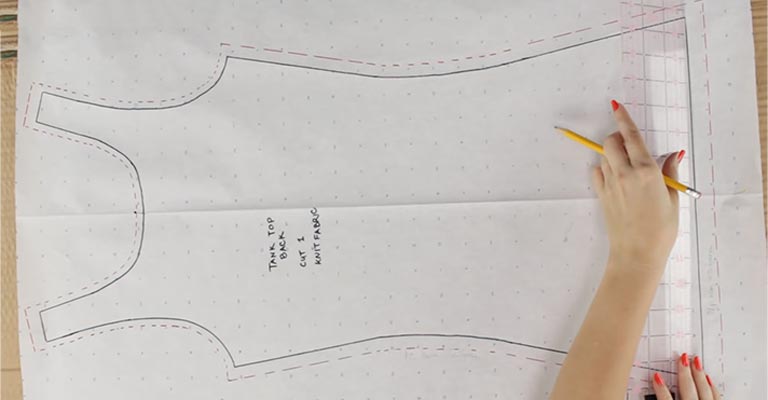In the realm of sewing and fashion, an uncut pattern represents the raw canvas from which masterpieces are crafted.
It’s the blueprint, the foundation upon which skilled hands and creative minds bring garments to life. Uncut patterns arrive in their pristine, original state, a pristine slate awaiting the touch of the craftsperson.
These patterns, often presented as paper or cardboard sheets, hold within them the promise of a specific garment, with each sheet serving as a puzzle piece in the intricate mosaic of design.
But what precisely does “uncut” signify in this context, and why is it of paramount importance to sewists and creators? This introduction explores the significance of uncut patterns in the world of sewing and fashion.

What Does an Uncut Pattern Mean?
An uncut pattern, in the context of sewing and fashion, refers to a sewing pattern that has not been altered or modified from its original state as produced by the pattern manufacturer.
These patterns typically come in a flat, folded paper or cardboard format and include various pieces and instructions for creating garments.
The term “uncut” signifies that none of these pattern pieces have been trimmed, altered, or adjusted by the user before use.
Here are some key points to understand about uncut patterns:
Original State
Uncut patterns are essentially untouched from their original production. When you purchase one, it comes with a set of pattern pieces on large sheets of paper or cardboard.
Each piece represents a specific part of the garment, like a sleeve, a collar, or a skirt panel. These sheets remain unaltered, so you get the exact design as intended by the pattern maker.
Instructions
The included instructions are an integral part of any sewing pattern, and uncut patterns come with these guidance materials.
These step-by-step instructions detail how to cut the pattern pieces, stitch them together, and create the final garment.
Following these instructions can be a valuable learning experience for both beginners and experienced sewists.
Sizing
Uncut patterns typically offer a range of sizes within a single pattern envelope. This means that you can select the size that best matches your measurements.
The uncut nature of the pattern allows for flexibility in creating garments of different sizes, making it convenient for sewing for yourself or others.
Variety of Styles
Sewing patterns come in an array of styles, from casual wear to formal attire. Uncut patterns provide the original design for your chosen style.
This means that if you want to make a dress with a specific neckline or a pair of pants with particular pocket details, the uncut pattern has all the elements required.
Personalization
While uncut patterns are ready for use, many sewing enthusiasts enjoy making personal alterations.
These modifications might include adjustments for a more tailored fit or customizing the design elements to match individual preferences. The uncut state of the pattern gives you a solid foundation for personalizing your creations.
Collectibility
Some sewing aficionados take a keen interest in collecting vintage, rare, or discontinued sewing patterns in their uncut state.
These patterns often offer a glimpse into historical fashion trends and are cherished for their unique designs.
Collecting uncut patterns can be a nostalgic and rewarding hobby for those who appreciate the art of sewing and fashion history.
Quality Control
When you acquire an uncut pattern, it’s important to inspect it for completeness and condition. Carefully check that all the pattern pieces are present and undamaged.
Missing or damaged pieces can be a significant obstacle in the sewing process. Additionally, inspect the instructions to ensure that they are clear and legible.
Uses of Uncut Patterns in Sewing

Uncut sewing patterns play a crucial role in the world of fashion and sewing, offering a wide range of uses for both beginners and experienced sewists.
Here are some of the key uses of uncut patterns in sewing:
Creating Garments
The primary purpose of uncut patterns is to provide a template for creating garments. These patterns guide the user in cutting fabric pieces and assembling them into clothing items like dresses, blouses, pants, jackets, and more.
Size Customization
Uncut patterns often include multiple sizes within a single pattern envelope. This allows sewists to select the size that best matches their measurements, providing a foundation for well-fitting garments.
Learning and Skill Development
Uncut patterns are valuable tools for beginners. They come with detailed instructions, helping novices learn essential sewing techniques, such as reading patterns, cutting fabric, sewing seams, and adding closures. As sewists progress, they can tackle more complex projects.
Consistency in Design
For those who wish to create the same garment in multiple sizes or for a group of individuals, uncut patterns ensure design consistency.
This is particularly useful for uniform production, such as making costumes for a theater production or clothing for a team.
Historical and Nostalgic Recreation
Collectors and historical reenactors often use uncut vintage patterns to recreate fashions from bygone eras.
These patterns offer insights into the styles and sewing techniques of different time periods.
Cost-Effective Sewing
Sewing with uncut patterns can be a cost-effective way to build a wardrobe. Making your own clothing allows you to control material costs and create high-quality garments at a fraction of the price of buying brand-new items.
Exploration of Different Styles
Uncut patterns come in a diverse range of styles, enabling sewists to explore and experiment with various fashion aesthetics, from vintage looks to contemporary designs.
Tailoring and Alterations
While uncut patterns provide a base design, they offer a framework for customization. Advanced sewists can use these patterns as a starting point for tailoring or altering garments to achieve a perfect fit or to add unique design elements.
Sewing Club and Group Projects
Uncut patterns provide a consistent starting point for group sewing projects. Whether it’s a sewing club, school project, or team activity, everyone can work from the same design, ensuring uniformity in the final products.
Prototype Development
Fashion designers and aspiring entrepreneurs use uncut patterns to create prototypes and samples of their designs.
These prototypes can serve as the foundation for production and help attract potential investors or customers.
Pros of Using Uncut Pattern

Using uncut sewing patterns offers several advantages for both beginners and experienced sewists.
Here are some of the key pros of using uncut patterns:
Original Design Intact
Uncut patterns maintain the integrity of the designer’s vision. This means you can be confident that the garment you create will match the original concept, with all its unique style elements and details.
Consistency
Using uncut patterns for multiple projects ensures a consistent starting point. Whether you’re making a wardrobe of basics or sewing uniforms for a team, uncut patterns offer uniformity, saving you time and ensuring consistency in your creations.
Ease of Sizing
Uncut patterns simplify the process of choosing the correct size for your project. By providing multiple size options within a single pattern, they eliminate the need for extensive resizing or pattern grading, making it easier to achieve a well-fitting garment.
Learning Experience
For beginners, uncut patterns are valuable teaching tools. The included step-by-step instructions can help novice sewists learn essential skills like cutting, pinning, sewing seams, and finishing edges. As you progress, these patterns can also introduce you to more advanced techniques.
Time and Effort Savings
Uncut patterns save you time and effort because they are ready for use. You can dive into your sewing project immediately, without the need to draft a pattern from scratch or spend hours altering existing patterns to suit your needs.
Variety of Styles
Uncut patterns come in a diverse array of styles, making them suitable for various occasions and personal preferences.
From everyday wear to special-occasion garments, you can find patterns to suit your needs and style.
Customization Flexibility
While uncut patterns provide a starting point, they also offer flexibility for customization. You can tailor the design to your liking, making adjustments for a more personalized fit or adding unique touches to create one-of-a-kind garments.
Historical and Collectible Value
Uncut vintage or discontinued sewing patterns are not just practical tools; they can also be cherished collectibles.
These patterns offer a glimpse into fashion trends of the past and can serve as sources of inspiration for contemporary sewing projects.
Consistency for Group Projects
When working on group sewing projects, uncut patterns ensure that all participants begin with the same design and instructions.
This guarantees a uniform outcome, making it suitable for sewing clubs, school projects, or team activities.
Economical
Using uncut patterns can be a cost-effective way to build your wardrobe. By creating your own clothing, you can save money compared to purchasing brand-new, ready-made garments, and you have control over the quality of materials used.
Creative Freedom
While uncut patterns provide a structured starting point, they also grant you the creative freedom to experiment.
You can choose fabrics, colors, and embellishments that reflect your unique style and vision, resulting in garments that are truly your own.
Cons of Using Uncut Pattern

While uncut patterns offer several benefits, they also come with some drawbacks and limitations that you should consider when deciding whether to use them for your sewing projects.
Here are some of the cons of using uncut sewing patterns:
Limited Personalization
Uncut patterns provide a specific design, which may not align perfectly with your personal style or fit preferences.
If you have specific alterations in mind, using an uncut pattern might not be the best choice, as it may require more effort to make significant changes.
Standard Sizing
While uncut patterns offer multiple sizes, these sizes are usually based on standardized measurements.
If your body shape deviates significantly from the standard measurements, achieving a perfect fit can be challenging, and extensive alterations may be required.
Skill Requirement
Uncut patterns, although accompanied by instructions, may not be suitable for complete beginners.
Understanding and following pattern instructions, cutting fabric accurately, and interpreting sewing symbols require some basic sewing skills. Novice sewists may find these aspects overwhelming.
Time-Consuming
While uncut patterns save time in the sense that you don’t have to draft a pattern from scratch, they can still be time-consuming.
Cutting out the pattern pieces, transferring markings, and following the instructions step by step can be a labor-intensive process, especially for complex designs.
Inflexibility in Design
If you have a unique or unconventional design in mind, an uncut pattern might not be the best choice. These patterns are fixed in their design, and making substantial design changes can be challenging and may even require drafting a pattern from scratch.
Pattern Layout
The pattern pieces on uncut sheets are often nested, meaning they share space to minimize paper waste.
This can make it challenging to cut out the pieces without accidentally cutting adjacent pieces, and it may require careful handling.
Pattern Alterations
If you decide to make significant changes to an uncut pattern, such as altering the neckline or adding custom features, it can be a complex process.
This might involve creating additional pattern pieces, making precise measurements, and altering the instructions.
Expense for Single Use
Some sewists may feel that uncut patterns are an unnecessary expense, particularly if they plan to sew a garment only once or have access to free or discounted patterns. In such cases, purchasing a full-priced uncut pattern may not be cost-effective.
Storage and Organization
Uncut patterns can take up storage space, and keeping them organized can be a challenge. Storing pattern envelopes and sheets requires a system to avoid misplacing pieces and instructions.
Difficulty in Reusing
If you wish to recreate the same garment in the future, the uncut pattern pieces can become delicate or damaged over time. Additionally, finding the correct size and pieces among multiple patterns can be cumbersome.
Frequently Asked Questions
Are all sewing patterns available in uncut form?
No, not all sewing patterns are available uncut. While many patterns are sold in their original, unaltered state, some patterns may be sold as “cut” or “partially cut,” which means they have been modified or trimmed in some way.
Can you re-use an uncut pattern for different fabrics?
Yes, uncut patterns are versatile and can be used with a variety of fabrics. You can create the same garment in different fabrics or experiment with different materials to achieve different looks.
Do uncut patterns include seam allowances?
Yes, most uncut patterns include seam allowances, which are typically indicated on the pattern pieces or within the instructions.
These allowances provide the necessary extra fabric for sewing seams and making adjustments.
Can I alter an uncut pattern for a maternity fit?
Yes, it is possible to adapt an uncut pattern for maternity wear. You can adjust the pattern to accommodate a growing belly, often by adding extra width at specific points, and following maternity sewing guidelines.
Do uncut patterns come with a recommended skill level?
Yes, many uncut patterns are labeled with a recommended skill level, such as “beginner,” “intermediate,” or “advanced.” This helps sewists choose patterns that match their sewing proficiency.
Wrap Up
In the vibrant world of sewing and fashion, uncut patterns stand as the unaltered blueprints of creativity.
These pristine templates offer a gateway to a realm of possibilities, where fabric transforms into elegant garments.
From the novice seamstress embarking on a learning journey to the seasoned designer crafting their visions, uncut patterns serve as the common foundation.
They are not merely sheets of paper; they are windows into history, gateways to personal expression, and tools for artistic innovation.
Whether you seek consistency, a learning path, historical accuracy, or a canvas for your imagination, uncut patterns embody the essence of fashion’s timeless artistry, transcending eras and evolving with each seam stitched.
Leave a Reply